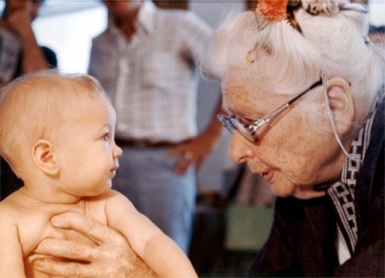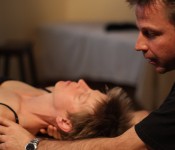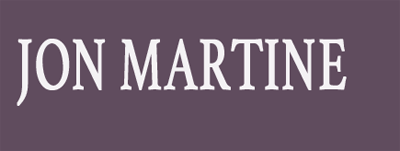Rolfing

What is Rolfing®?
The main type of therapy that I practice is called Structural Integration, more commonly known by the trademarked name of Rolfing® (after Dr Ida P. Rolf, the founder of this remarkably ground-breaking discipline of body-work).
Rolfing® is not the prettiest of names for a treatment, but it is an especially effective way to bring a remarkably higher level of health and well-being to your life. to your lifes form, as it were.
When your physical body is working well and you are happy in your body, your outlook on life, and the expression of your abilities, will have a certain more pleasant and harmonious quality to them.
When, on the other hand, your body gets into trouble, the physical issue usually affects or influences your mood and outlook as well as your ability do the things you enjoy doing, as well as duties you may be obliged to perform.
The *manner* in which we exist and behave, in and through our physical selves, plays a remarkably large part in how we perceive, interact with and experience the world around us.
Persistent discomfort, whether physical or emotional, even when we are ignoring it, colours the quality of our interactions with others and the look and feel of the world around us.
On the other hand, when a body is free from restrictions and imbued with health and feelings of well-being and aligned energyflow, the experience and outlook of the person whose body it is will have a lightness and effectiveness that may have never been there before or may have been missing for many years.
I came to this discipline after having an injury treated by a Rolfer. Feeling the profound difference it made to me and my life I made a mental note to return to it at some point to explore it more deeply.
I know that I am a lot more productive and happy when my physical body is operating well. When I feel well in my body, I also feel more connected to the planet, other people, and to life itself.
In what follows, I shall do my best to explain simply and clearly what this sophisticated and yet simple treatment programme that we call “The Rolfing Basic Series” is.

What is Rolfing®?
Quite simply, Rolfing® is a kind of body based therapy whose aim is to release restrictions in the connective tissue and restore or augment healthy function. This is done largely by aligning the body with respect to the field of gravity. This system yields many, many positive results, including better posture, the resolution of various body aches and pains, as well as providing a greater measure of general emotional or psychological well-being to those who undertake the course of treatment.
Rolfing® is not, as many people think, deep tissue massage.
Originally called Structural Integration, Rolfing® was developed in the 50s and 60s by Biochemist Dr Ida P. Rolf, from whom it takes its name. It has more in common with Osteopathy and Physiotherapy than massage, though it does contain elements of each of them. It is a unique therapy having its basis in Bio-mechanics but is influenced by understandings from other disciplines, including Hatha Yoga and Cranio-Sacral therapy.
Our approach as body-workers is to, by turns, bring the various segments of the human form back into alignment with gravity wherever insult or injury have caused chronic contraction of muscles, tendons, ligaments, and fascia.
In addition to aligning with respect to gravity, we also work to bring adaptability between the segments themselves.
If we take a higher view, then our overarching aim is to simply create or hold a safe space where the client can find resolution for troubling issues and invoke a greater measure of well-being, grace and joy.
It may sometimes sound a little complicated when Rolfers talk about what they do, but ultimately our aims are simple:
more comfort, ease and well-being in your body; comfort, ease and well-being that are lasting and that come from having a physical structure that is more optimally balanced and thus fostering the feeling of being more deeply connected to your own core-being.
Rolfing is not a quick fix. One of the distinguishing features of this therapy is that it is designed as a process, or programme of ten or twelve separate sessions, systematically and methodically working through the whole body to provide true, deep and lasting integration. This is experienced not only physically, but also for most people, psychologically and emotionally.
Basic Rolfing is a methodical process of release, re-alignment and re-education of the body and nervous system. Intermediate and Avanced Rolfing are less method-bound and they tend to capitalise on the attainments of the Basic 10-Series.
The chief means to attain the sought-for results are threefold:
1. Skillful Touch
2. Conscious Movement
3. Patient-practitioner Rapport
Skillful Touch:
This has been defined variously, but basically it is a good combination of intelligent and intuitive touch. The best body workers approach their work both scientifically and as an art.
Conscious Movement:
Unlike a massage, Rolfing is not purely a passive experience; the client participates in the session. This has several benefits. One is that it brings awareness to areas of the body where previously there was unconsciousness. Specific movement is often asked for as the therapist works to free a particular area. This movement coupled with the manipulation of tissue greatly increases the degree of release. This is deliberate, attentive movement, guided by the practitioner which re-educates the muscles and neural system to new, more efficient and graceful uses of the limbs and body as a whole.
Patient-Rolfer Rapport:
This is crucial to stay in communication with regard to how something feels, and to stay within agreed-upon comfort zones. I occasionally use a scale between one and ten with my clients so they can let me know whether I can or should work more deeply or more lightly, avoiding unnecessary discomfort or pain.
One of the other things that makes it remarkably effective is that in addition to working with muscles and joints, bones and tendons, Rolfers are very interested in something called Fascia. This is the tissue that covers muscles and interpenetrates them. It is elastic and has a kind of memory. It is enervated tissue and provides access to a deeper intelligence in the body, sometimes called the neural net.By working on this tissue to lengthen and free it, more lasting change takes place than if we were only working on muscle, ligaments and tendons. The Rolfer gives input to the nervous system resulting in smoother, more effortless posture and body motion. It is possible to make clear impressions on the neural net that inform it such that new more appropriate movement patterns are adopted.
Rolfing treatment is based on what we call The Basic 10 Series. This consists of ten distinct sessions. Each session is unique, and at the same time is part of a greater whole, with each level building on the work of the previous ones, or, in another sense, and perhaps a little more accurately, releasing progressively deeper and deeper structures as those areas become available for work.
In an automobile, you can’t repair certain parts deep inside the engine until you undo, and move out of the way, the outer bits that are blocking access to the areas you need to reach. In principle, the body is the same: outer layers of armouring and tension need to be softened or released before any real and useful lasting adjustment can be made deeper inside, properly getting to the area that needs attention.
Here is a quick overview of the theme and major content of each session of the series:
1. Freeing the breath: muscles and structures involved in respiration
to evoke a more balanced breathing pattern by working around the ribcage, shoulders, neck and head. This session also begin the process of mobilizing and horizontalising the pelvis by working around the hip joint and legs.
2. Support : The foot, lower leg and knee
Support is the theme. In this session I focus primarily on the lower body, working on feet, legs and knees to create a more stable base of support for the upper body. I seek to straighten or enhance the spinal curves as appropriate, by working in the lower, middle and upper back, and in the neck.
3. Side Dimensions: Freeing the ribs and the hips
Here my goal is to enhance front to back balance and to continue working with the client’s breathing pattern, further freeing the ribs from one-another and the ribcage itself from the pelvis. This session also ties the previous two together with further work on the side surfaces of the legs, the hips, torso, arms, neck and head.
4. The Rolfing Line: The Inner mid-line of the body
Now we begin working to establish core support in the legs. From the inner arches of the feet up through the inside surfaces of the legs, support is created while old tensions and incorrect arrangement of connective tissue is addressed and corrected.
5. The Diagonal Space: Psoas/Rhomboid balance
In this session we lengthen and soften the outer abdominal wall, work in the tissues that line the front of the torso and pelvis to create a more balanced relationship between inner and outer structures. Enhance communication and connection between legs and spine through release and lengthening of illiopsoas muscle.
6 Freeing the spinal column: sacrum, spine and soleus
Free the back of the legs and pelvis. Establish more freedom of movement and resilience in the whole spine through work around the back of the pelvis, the outer spinal channel, neck and head. Here we also address the sacrum and the coccyx.
7. Putting the head on Continue treating upper back, shoulders and neck. Here we also sometimes work on the jaw and facial structures. Up to this point, with regard to function and structure, the focus has been slightly more on the undoing than doingmore taking things apart, unhooking, differentiating, in order to then put them back together in more efficient and comfortable arrangement.
8, 9 & 10 are usually integration sessions unique to each client and custom designed with regard to what areas are best addressed. The emphasis is on bringing together the renewed body segments and the majority of time is spent on the remaining individual problems. Here was work to create better upper to lower body integration, establishing horizontal planes of support and movement from the feet up. In the last session there is a final integration and closure.
The basic series is complete in itself, however many people find that they wish come occasionally for maintenance treatments. Frequency varies, but generally it is once or twice every six months. It is useful to wait several months as the process of adaptation and integration continues in the body even months after the series is over.
Rolfing® is more properly an approach, than a method or collection of techniques.
While there are hundreds, and possibly thousands of techniques for a Rolfer to choose from, it is not the techniques themselves that make Rolfing what it is. It is the trained mind, and approach of the practitioner, the way he sees the body in front of him, and how the working strategy is formed in progressive steps.
It is considering treatment strategy with regard to how treatment will affect, and be affected by, adjoining areas of the body.
it is being able to mingle intuition with experience and sound judgment to assess the emotional and physical condition of the patient and determine just how to proceed in each specific instance and with which method or approach.
Although treatment sessions are largely body-centered, some Rolfers do not neglect the emotional component and in such cases there are opportunities for emotional content to be discussed if appropriate, and then worked with, and if a willingness is there, released.
Rolfing® is for patient people. (or for people who wish to become somewhat more patient and tolerant!) That is to say that it works very well in the great majority of cases, but it is not a quick fix therapy. Often, there are significant changes and releases of long-held tension very early in the series, but the Rolfers eye is on the future as well as the present, looking to provide medium and long-term structural and functional changes, benefits that either will last a lifetime, or will last for years to come.
Some of the top reported benefits:
Pain Relief
Increased energy and awareness
Easier and even effortless posture
Freedom of movement
Deep level of release and relaxation
Deeper, more refreshing sleep
Better blood flow and circulation
Release and elimination of toxins
“When the body gets working appropriately, the force of gravity can flow through. Then, spontaneously, the body heals itself.
There is an ongoing psychological change as well toward balance, toward serenity, toward a more whole person. The whole person evinces a more apparent, more potent psychic development.”
-Ida P Rolf, Ph.D.
We live what we know: If we believe the universe to be mechanical, we will tend to live mechanically.
Nature, we are learning, is not merely a collection of forces over which we must triumph,
but the very medium of our transformation.
– Marilyn Ferguson, The Aquarian Conspiracy.
Note Regarding the Qualifications of a Rolfing Practitioner:
To qualify as a Rolfer either requires a university degree or its equivalent in experience in exposure to biology (advanced study of Anatomy and Physiology 1yr), massage or physiotherapy, and from one to two years study at one of the Rolf Institutes variously located in Munich, Germany, Colorado (USA), Brazil, Japan and Australia (UK in 2009). There is also a requirement of a 20-30-page dissertation, entrance examinations, interviews and a fairly rigorous selection process for admission to one of the course programs.
To keep their certifications current, all Rolfers are required to attend workshops and to periodically update, assess and refresh their skills and understandings..

